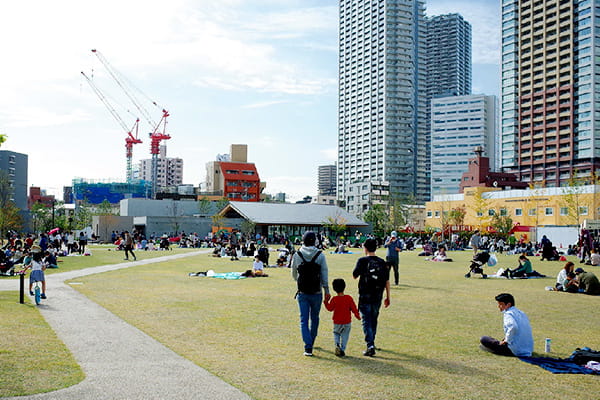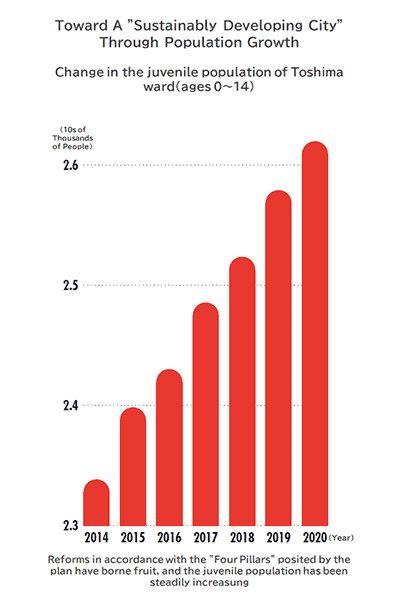Toshima Ward
A Walk Through Toshima Ward, Where Nostalgia Remains
The route that takes visitors around the various areas of Toshima Ward, which stretches across a wide area from east to west, is one of the ward’s charms. Even in Toshima, which has the highest population density of all of Tokyo’s 23 Wards, there are districts, such as Zoshigaya and Mejiro, which are like air pockets that help visitors forget about all the hustle and bustle. And in Otsuka and Sugamo, the appearance of 20th-century Tokyo, otherwise disappearing due to redevelopment, still remains. It’s not just the bustle of Ikebukuro: we hope you’ll enjoy a walk through Toshima Ward, where time flows at a more leisurely pace.
Research/Writing/Photography: Hiroki Kameyama (Editorial Board)
Mejiro
Forget the hustle and bustle in a Japanese garden and on a tree-lined avenue
Right in front of you as you exit the Mejiro Station ticket gate, looking toward the enormous white chimney of the Toshima Incineration Plant, if you follow the narrow street in the direction of Ikebukuro, you will pass through and out of a residential neighborhood, whereupon a Japanese garden surrounded by white walls will come into view.
This is Mejiro Garden, which opened as a brand-new Japanese garden in 1990. When you go through the front gate, take a breath, and look from the Rokkaku-Ukimido rest spot on your right to the graceful form of the Sekicho-an, built in the style of a tea ceremony arbor from Kyoto Kitayama cedar trees, you will forget that you’re in the middle of the city.
The name “Sekicho-an,” which means “Red Bird Retreat,” is connected to the magazine Akai Tori, or “Red Bird,” published by Miekichi Suzuki, a children’s author and longtime resident Toshima ward who was active during the Taisho Era (1912~1926).
Sekicho-an is used for things like arts lessons and performances. It is popular with users, who can look at the reflections of the garden’s trees in the water’s surface as they enjoy a tea ceremony or gathering of haiku poets.
The interior of the garden presents a different image with the flowers that change from season to season-- weeping cherry blossoms in spring, hydrangeas in early summer, maples in autumn-- calming the hearts of visitors.
Heading east, back toward Mejiro Station, you will walk down Mejiro-dori Avenue, seeing the campus of Gakushuin University, with its dense, thickly-growing trees, beside you. The trees that line the road create a peaceful atmosphere. Within Toshima Ward, known for being the most densely populated of all of Tokyo’s 23 Wards, Mejiro is an area that will make you forget about the big-city hustle and bustle. It’s enjoyable to walk the streets at a leisurely pace until you reach Ikebukuro.
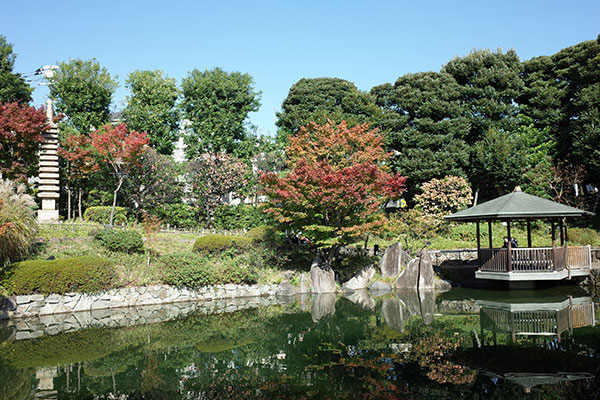
It is beautiful when the autumn leaves of the garden’s trees are reflected in the surface of the pond.
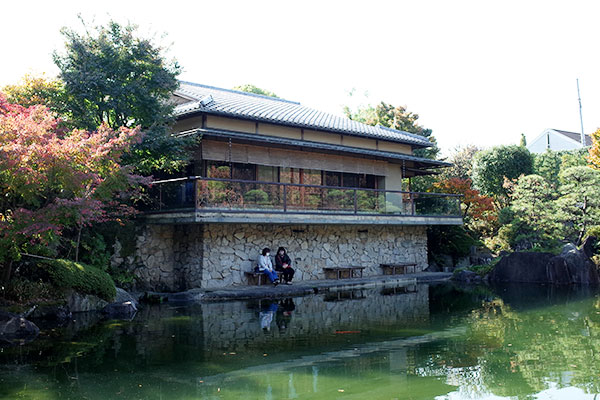
Sekicho-an, as seen from the other side of the pond. A promenade has been installed in front of its stone walls.
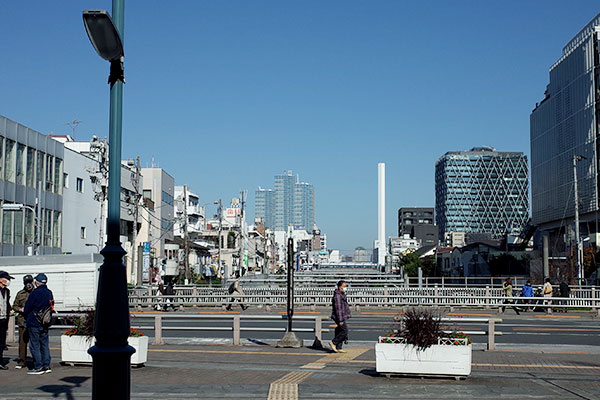
Looking toward Ikebukuro from Mejiro Station. Straight ahead is the white chimney of the Toshima Incineration Plant.
Shiinamachi
Walk the streets and reminisce about Ikebukuro Montparnasse
Shiinamachi is directly adjacent to Ikebukuro Station, the first station on the Seibu Ikebukuro Line. The area of land encompassing the next station, Higashi-Nagasaki, where the Tokiwa-so Manga Museum is located, as well as Kanamecho and Senkawa Stations on the Tokyo Metro Yurakucho Line, had cheap rents during the Taisho Era, before the area was more heavily developed, so naturally young artists congregated there. Sometimes called Nagasaki Atelier Village or Ikebukuro Montparnasse, the region became an artistic version of Liangshan Marsh, the gathering place of the outlaw heroes of the Chinese novel The Water Margin.
The area is still a pleasant place to live even now, and once you pass through the popular shopping centers of Suzuran Street and Sun Road, a five-minute walk will take you to the heart of the former Atelier Village. It is currently a residential area, but if you head further along, toward Senkawa Station, there will be the Art Museum of Morikazu Kumagai, a standout painter who is an exemplar of Ikebukuro Montparnasse.
How about moving across the edge of this ward, into the neighboring wards of Shinjuku and Nerima, until your feet bring you to places like the Yuzo Saeki Memorial Atelier Hall (in Nakaochiai, Shinjuku), whose namesake artist is famous for his depictions of Paris? It is enjoyable to give some nostalgic thought to the culture of freedom that blossomed here on the outskirts of Toshima Ward during the Taisho Democracy era, that brief period of peace sandwiched between two world wars.
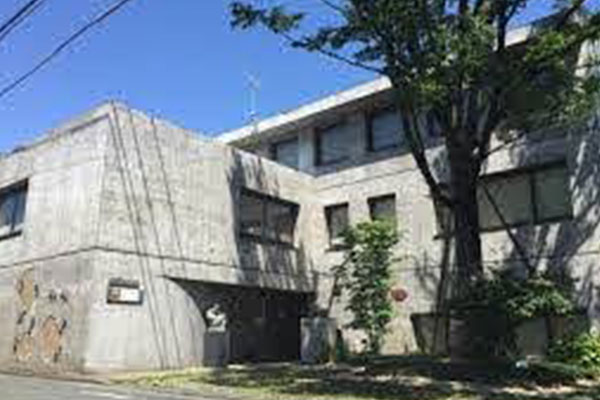
The Morikazu Kumagai Museum. Kumagai lived in Toshima Ward from 1932 until his death in 1977.
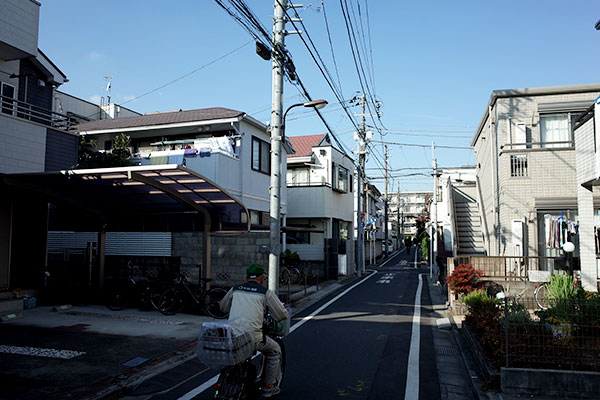
The former site of Sakuragaoka Parthenon, the largest group of ateliers in Ikebukuro Montparnasse. At present, this is a residential neighborhood.
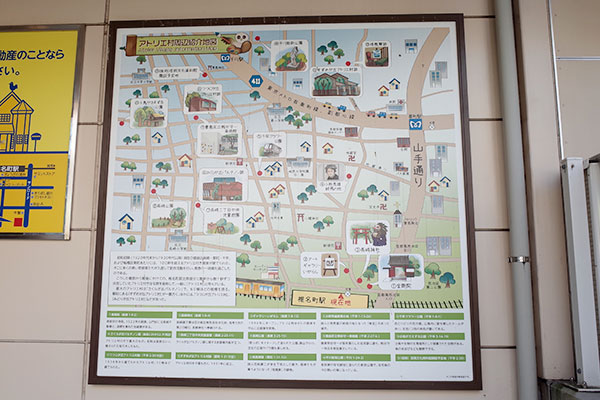
An atelier walking map, located at the north gate of Shiinamachi Station.
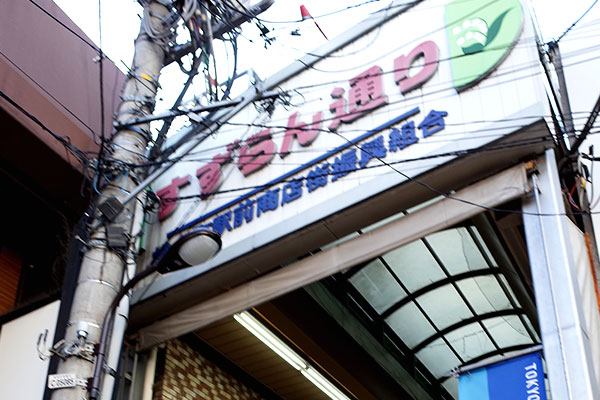
The Suzuran Street shopping district stretches out from the station’s north gate. Atelier Village was clustered around the area just north of where it ends.
Sugamo
It’s fun to walk around this “Harajuku for Grandmas”
Sugamo, a district which people call “Harajuku for Grandmas,” developed as the town around Togenuki Jizoson/Koganji Temple. Its nostalgic but lively shopping districts, including Sugamo-Ekimae Shopping Street, Sugamo Jizo-Dori Shopping Street, and Koshinzuka Shoeikai, extend as far as the Koshinzuka stop on the Toden-Arakawa tram line.
In particular, the 4th, 14th, and 24th of every month are festival days at Koganji Temple, when the crowd in the area increases considerably.
Sugamo Jizo-Dori Shopping Street is lined with many shops, including bars, restaurants and general stores, but the lineup of products carried by the stores that deal in clothing and daily-use items, such as Maruji, known for being “Japan’s only red underwear store,” is actually distinctive and abundant. In the middle of the coronavirus pandemic, there were some stores here that kept well-stocked with masks that were otherwise totally unavailable due to temporary shortages.
We also want to try enjoying a walk through Komagome’s Someiyoshino Sakura-no-Sato Park, known as the place where the Somei-Yoshino variety of cherry trees originated.
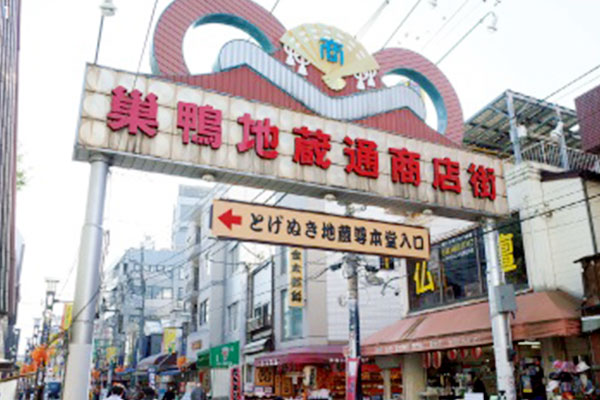
Sugamo Jizo-Dori Shopping Street. In addition to shopping, of course, walking around the area is also enjoyable.
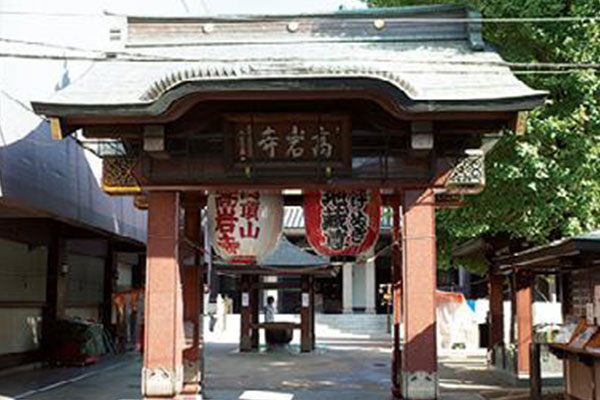
The main gate of Koganji Temple, also known as Togenuki Jizoson. It is in the middle of Sugamo Jizo-Dori Shopping Street.
Otsuka
A town of fun nightlife where the Tokyo spirit still remains
Located one stop past Ikebukuro Station on the JR Yamanote Line, Otsuka is a town with many different facets.
Otsuka, which was originally built as the town surrounding Otsuka Tenso Shrine, once flourished as a red-light district and is now home to a number of restaurants.
Although the Tokyo Olympics were, unfortunately, postponed, Toshima Ward has been trying to make “Tokyo 2020”-themed appeals to nightlife tourists (such as those who have just left theater performances). Deriving from the Vision For An International City Of Art And Culture introduced in this issue’s special feature, this is an effort to get visitors to drink and walk through Otsuka, a town filled with distinctive eateries, and experience its food culture.
Directly behind OMO 5, a Hoshino Resorts hotel which opened just this year, is Tokyo Otsuka Noren-Gai, a side street lined with bars. Going drinking here, then staggering back to one’s hotel, is just one of the ways to enjoy Otsuka.
Otsuka is also a tramway district. Beneath the elevated tracks of JR Otsuka Station is the Otsuka-ekimae stop of the Arakawa Line (also known as the Tokyo Sakura Tram), the only remaining line of the old Toden tram service. This spot serves as the ideal hub for hopping on the tram and exploring along the line.
The opening of the Atre Vie Otsuka shopping mall in the JR East Japan building greatly changed the image of Otsuka Station itself, but the atmosphere in the town that stretches out to the north and south remains as it was long ago, probably because it is a town with a tram running through it. When one goes out of the ticket gate and walks around, sometimes the tram cars will slowly come into view before heading off at a pace leisurely enough for bicycles to ride alongside it.
Otsuka is also known for being an area with a lot of hills even for Tokyo. When first-time visitors dismount the train, they feel somewhat as though they are in a labyrinth, probably due to the way the ground rises and falls all throughout the area. It is no wonder that Otsuka Station, which the Yamanote Line slides into as it comes down from the high elevation of the Toshima Plateau on which Ikebukuro is located, is on a piece of land in a valley carved by the Yabata River (which now flows entirely through underground pipes), such that the traffic roundabout right in front of the north gate is at the lowest point. We look forward to walking across the ups and downs that come with each section of the road.
If one goes from the station’s north exit and follows along the JR Line, climbing a hill, one will reach Utsusemi Bridge, an area with a line of cherry trees that feels very pleasant to be in when April comes.
The spirit of Tokyo has been gradually disappearing, but even now it remains markedly present in Otsuka. We hope you’ll take a leisurely stroll through the town.
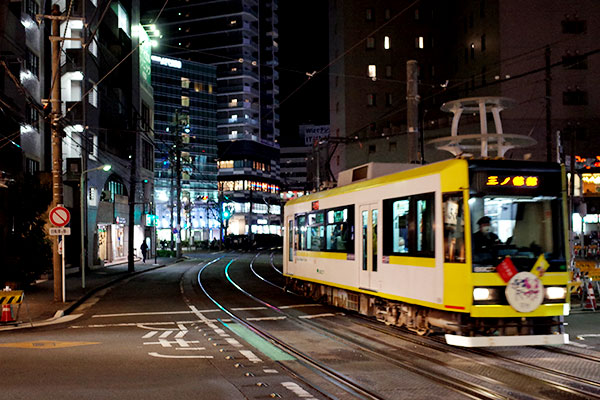
A tram car from the Toden-Arakawa Line passes through the Otsuka area at night.
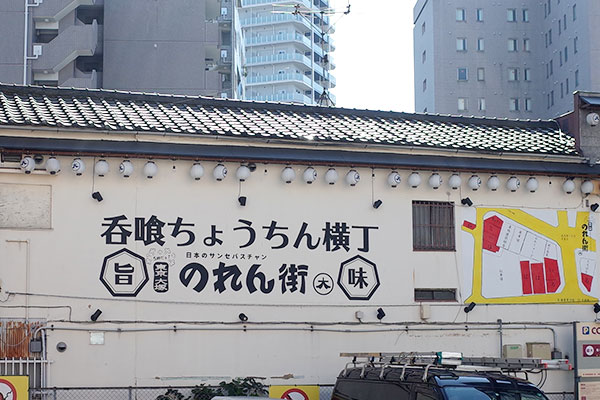
Tokyo Otsuka Noren-Gai sits beside the tramway tracks. This backstreet is lined with bars.
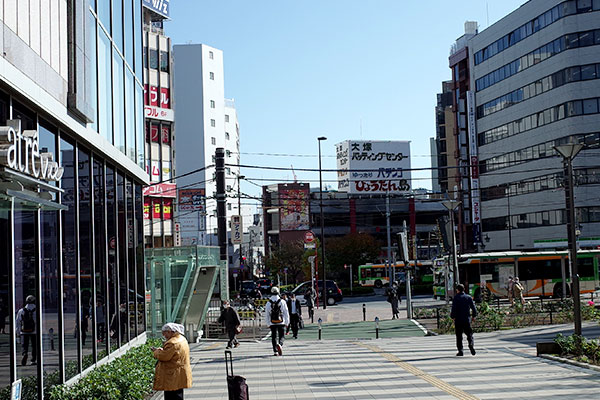
There are several hills and valleys even in the plaza outside the south gate of Otsuka Station, and they slant toward the tram tracks. In this picture, one can see a batting center that has been there since 1966.
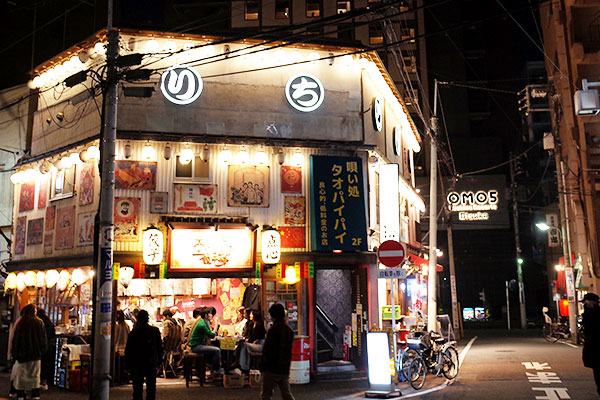
Noren-Gai overflows with drunk people once night comes. At the end of the street, the Hoshino Resorts hotel OMO 5 is visible.
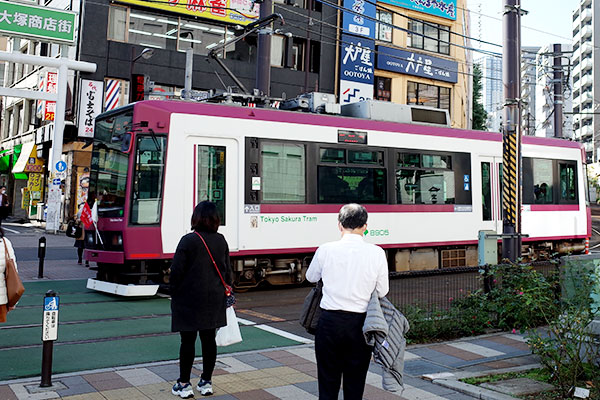
The tram passes by the south gate as it heads toward Waseda.
All Toshima
For A Town Where Anyone Can Be A Star
In 2014, Toshima Ward was designated “a city at risk of disappearing.” In order to devise a way to turn things around and make this “a sustainably developing city,” the ward government has moved forward with projects to help keep people of child-rearing age in place and increase the population. As a result, they have achieved a major transformation of the town into a place where raising children is easy and there is a strong scent of culture in the air. They continue to move forward with this, in hopes of becoming a “City Of International Art And Culture” by 2030. We spoke about the projects to the ward employee in charge of them.
Research/Writing: Kimiko Maruyama
Photography: Editorial Board
From A Shocking Declaration To Planning A Shift To A Sustainably Developing City
It was in 2015 that this magazine last had a special feature about Toshima Ward. The previous year, this ward had been determined to be the only one of Tokyo’s 23 Wards that was “a city at risk of dying out,” sending a shock running through the Ward Hall.
“In 1992, when the economic bubble crashed, our public finances fell into debt, with our liabilities swelling to as high as 83.6 billion yen in 1999. However, due to various administrative reforms, we made it back into the black in 2014. That was when we became able to see the path to full financial health. We were all the more shocked at the designation because the image of Ikebukuro as a place of “3 Ds-- Dreadful, Dark, and Dirty” had been changing, and around that time it had placed third on Recruit Housing Company’s yearly “Liveable Town Ranking” survey,” said Planning Section head Toru Yamanobe of the state of the ward at the time these efforts began.
But the ward government’s response was quick, and they established a countermeasures headquarters soon after that determination had been made. Deciding to “turn this crisis into an opportunity,” they put out the following four pillars for the purpose of breaking away from being a city at risk of dying out and creating a sustainably developing city.
A pleasant town for women and children
A town where people can continue living happily when they grow older
A town that plans to coexist and mix with various other areas so that residents are able to have rich lives
A city of international art and culture that serves as part of the driving force of Japan
Due to the reforms implemented in accordance with these basic principles, the ward has achieved a startling transformation.
“In 2017, the number of children on waiting lists for kindergarten and daycare reached zero. People of family-raising age are flowing into the area: On January 1, 2014, our total population was 271,643; by January 1, 2020, it had reached 290,246. In terms of growth rate, that’s an increase of 6.8%. What stands out in particular is that the population of children aged 0~14 years went from 23,382 to 26,202, an increase of 12.1%, while the population of young women, aged 25~34 years, rose 7.2%, from 40,520 to 40,806. An increase in population leads to an increase in tax revenues, making it possible to develop a more stable budget.”
Toward A City Of International Art And Culture With A Good Mix Of Hard And Soft
In 2019, Toshima Ward was selected as a City of East Asian Culture, providing it with a further opportunity to make rapid progress. City of East Asian Culture is an event in which one municipality each from Japan, South Korea, and China participate, visiting each other and holding arts and culture functions. This served as the impetus for them to set their sights on when Tokyo will host the Olympics; they started 23 town development projects, including opening a new theater and four parks in the Ikebukuro area and putting the Ikebus service into operation.
“What was most distinctive about this was that it wasn’t just the government: exchange was going on at the residential level, and we were active as ‘All Toshima.’ In particular, we had 1400 people and groups participating as City of International Art and Culture Mission Ambassadors, including ward residents, businesses, organizations, and students, who worked hard and kept things going.”
They created the basic material for a City of International Art and Culture, one with a good balance of hard and soft, “a theater city where the whole town is a stage and anyone can be a star.”
Additionally, the ward’s policies to this point have been in keeping with the philosophy of their Sustainable Development Goals, which “aim to realize a society in which not one person on earth is left behind.” Aiming to capitalize on their strengths, they applied to become a Sustainable Development Goals Future City and join the Municipal Sustainable Development Goals Model Project, both of which Cabinet Office is recruiting for, and they were selected for them in July 2020. They were the first municipality within Tokyo to be selected for either of these.
“Following being selected, we aren’t changing the projects that we were already engaged in or the direction we’re heading in, but, by having an awareness of Sustainable Development Goals from the point of view of the three facets of economy, society, and the environment, we think that we will be able to implement these projects with a greater degree of balance.”
Toshima Ecomusee Town, which serves as the Toshima Ward Hall, was completed in 2015 as the first ward hall in Japan to be combined with an apartment building. The upper floors of the building serve as a housing complex The math here is inaccurate, but this is what the article says.
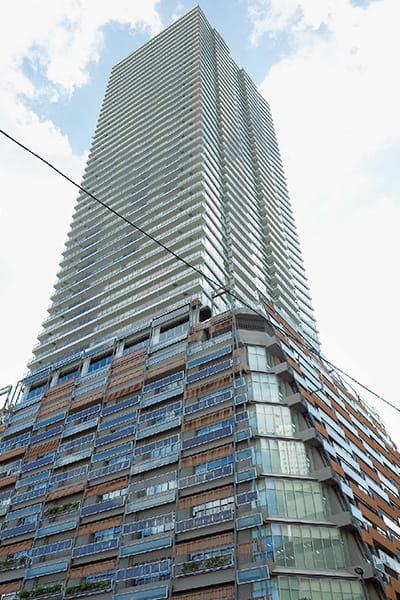
Toshima Midori Disaster Prevention Park (also called Ike Sun Park), directly beside the Ikebukuro Sunshine building, opened in 2020. It is a place for many residents to gather, especially the younger generation.
